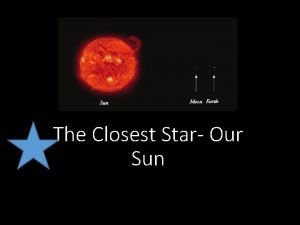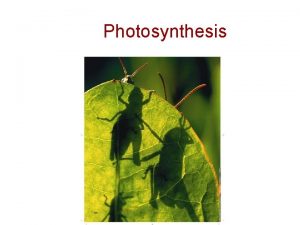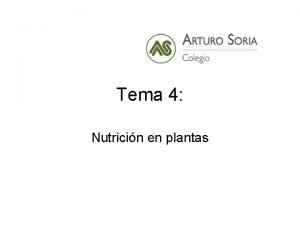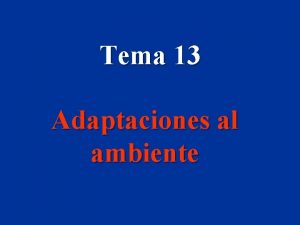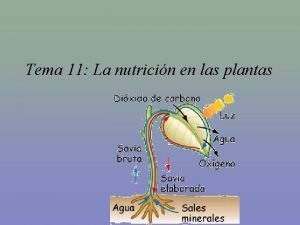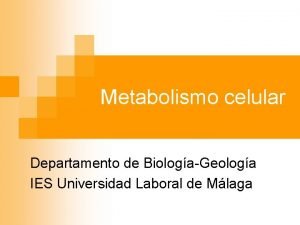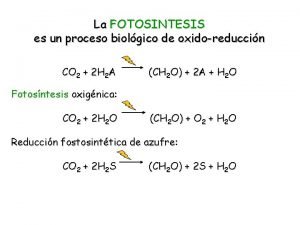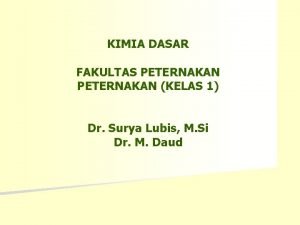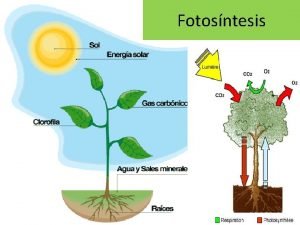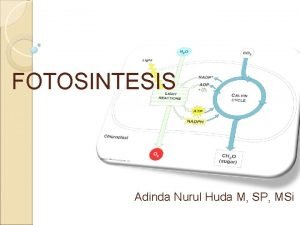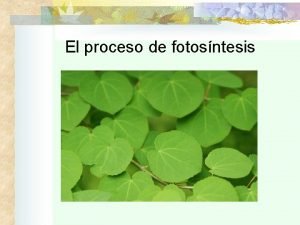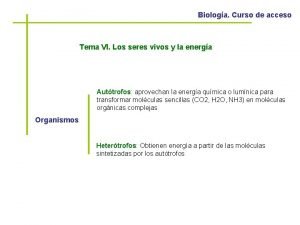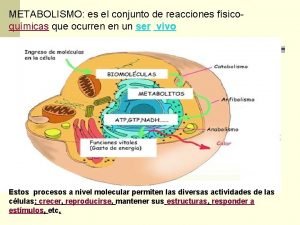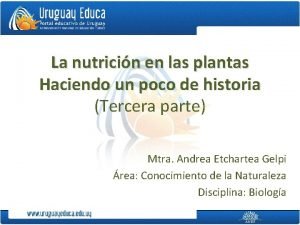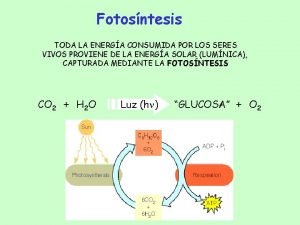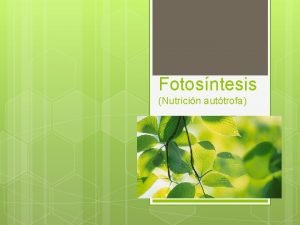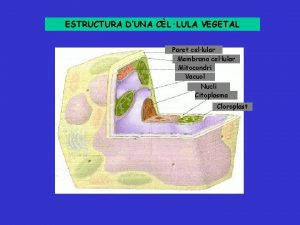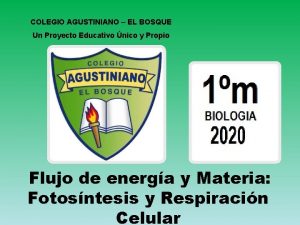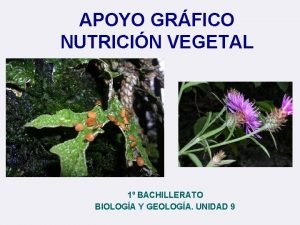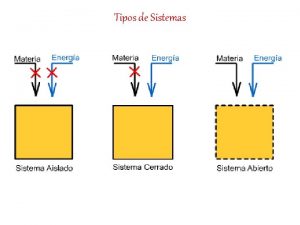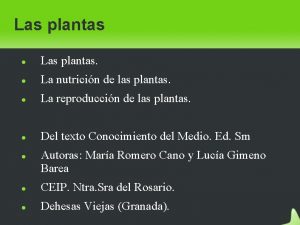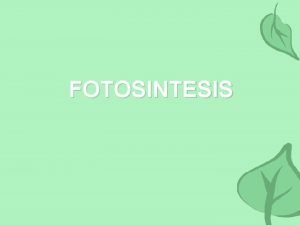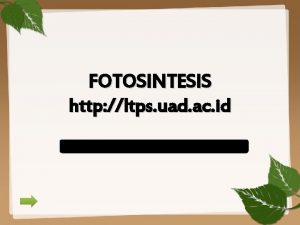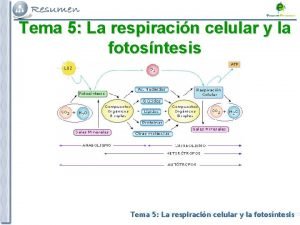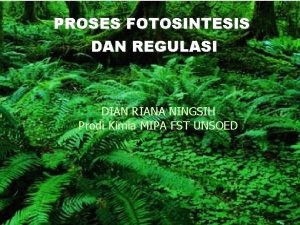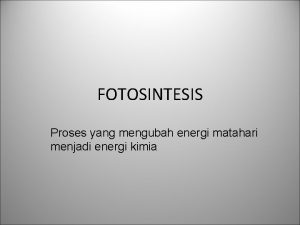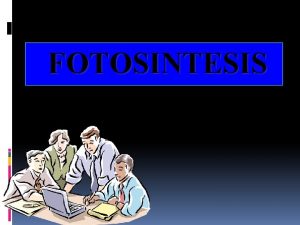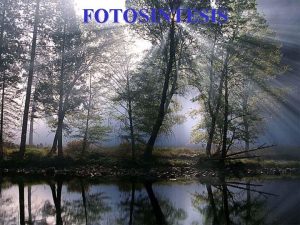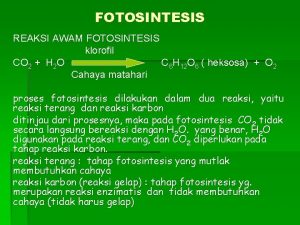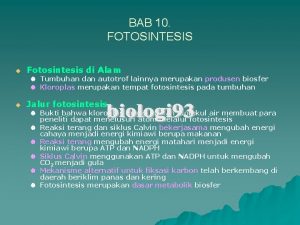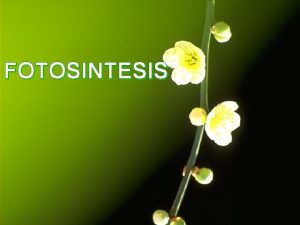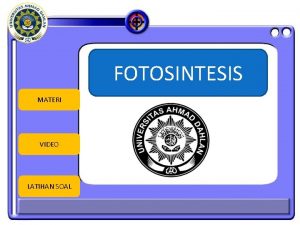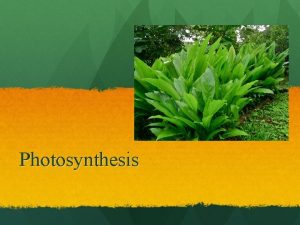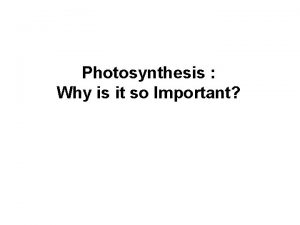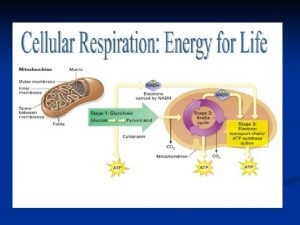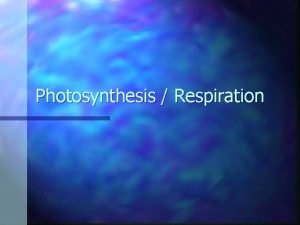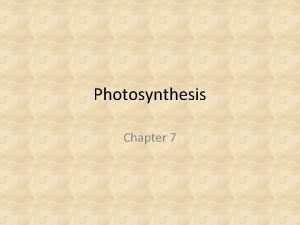FOTOSINTESIS Why Photosynthesis is Important THE SUN MAIN









































- Slides: 41

FOTOSINTESIS

Why Photosynthesis is Important?

THE SUN: MAIN SOURCE OF ENERGY FOR LIFE ON EARTH



DI MANA TEMPAT TERJADINYA FOTOSINTESIS?

The location and structure of chloroplasts Chloroplast LEAF CROSS SECTION MESOPHYLL CELL LEAF Mesophyll CHLOROPLAST Intermembrane space Outer membrane Granum Grana Stroma Inner membrane Stroma Thylakoid compartment

Photosynthesis occurs in chloroplasts • In most plants, photosynthesis occurs primarily in the leaves, in the chloroplasts • A chloroplast contains: – stroma, a fluid – grana, stacks of thylakoids • The thylakoids contain chlorophyll – Chlorophyll is the green pigment that captures light for photosynthesis

WHY ARE PLANTS GREEN? Plant Cells have Green Chloroplasts The thylakoid membrane of the chloroplast is impregnated with photosynthetic pigments (i. e. , chlorophylls, carotenoids).

Electromagnetic Spectrum and Visible Light Gamma rays X-rays UV Infrared & Microwaves Visible light Wavelength (nm) Radio waves

KENAPA DAUN BERWARNA HIJAU? Different wavelengths of visible light are seen by the human eye as different colors. Gamma rays X-rays UV Infrared Visible light Wavelength (nm) Microwaves Radio waves

THE COLOR OF LIGHT SEEN IS THE COLOR NOT ABSORBED • Chloroplasts absorb light energy and convert it to chemical energy Light Reflected light Absorbed light Transmitted light Chloroplast

Chloroplast Pigments • Chloroplasts contain several pigments – Chlorophyll a – Chlorophyll b – Carotenoids

Chlorophyll a & b • Chl a has a methyl group • Chl b has a carbonyl group Porphyrin ring delocalized e- Phytol tail

Different pigments absorb light differently


THERE ARE TWO PHASES IN PHOTOSYNTHESIS • THE “LIGHT REACTION” – H 2 o is split • 2 H 2 O O 2 + 4 [H+] – NADPH and ATP are generated • THE “DARK REACTION” – NADPH and ATP from the light reaction drives CH 2 O production. CO 2 AND [H+] : • 4 [H+] + CO 2 (CH 2 O) + H 2 O – It’s really light in-dependent reaction – You have already studied it • THE “CALVIN CYCLE”


Cyclic Photophosphorylation • Process for ATP generation • Reaction Center => 700 nm

• Two types of photosystems cooperate in the light reactions Photon ATP mill Water-splitting photosystem NADPH-producing photosystem

Noncyclic Photophosphorylation • Photosystem II regains electrons by splitting water, leaving O 2 gas as a by-product El Primary electron acceptor El ec t ro n tra ns po rt ec tro n tra ns po rt ch ain Photons Energy for synthesis of PHOTOSYSTEM II by chemiosmosis

Plants produce O 2 gas by splitting H 2 O • The O 2 liberated by photosynthesis is made from the oxygen in water (H+ and e-)


The production of ATP by chemiosmosis in photosynthesis Thylakoid compartment (high H+) Light Thylakoid membrane Antenna molecules Stroma (low H+) ELECTRON TRANSPORT CHAIN PHOTOSYSTEM II PHOTOSYSTEM I ATP SYNTHASE

Overview of Light Reactions

Calvin Cycle • • • Where does the Calvin Cycle occur? In the stroma What goes into the Calvin Cycle? ATP, NADPH, Carbon Dioxide What comes out of the Calvin Cycle? Sugar, ADP, NADP+


carbon fixation phase

• each CO 2 molecule is attached to a fivecarbon sugar, ribulose bisphosphate (Ru. BP) • catalyzed by Ru. BP carboxylase or rubisco • six-carbon intermediate splits in half to form two molecules of 3 phosphoglycerate

reduction of CO 2 phase

• each 3 -phosphoglycerate receives another phosphate group from ATP to form 1, 3 bisphoglycerate. • pair of electrons from NADPH reduces, Gain, each 1, 3 bisphoglycerate to G 3 P. – Electrons from NADPH change a carboxyl group to a carbonyl group.

regeneration of Ru. BP phase

• regeneration of the CO 2 acceptor (Ru. BP), these five G 3 P molecules are rearranged to form 3 Ru. BP molecules. • cycle must spend 3 more molecules of ATP (one per Ru. BP) to complete the cycle and prepare for the next.


Rate of Photosynthesis • What is a rate? • It is the activity per unit time. • What factors can affect the photosynthetic rate?

Light Intensity

The Effect of Light Intensity on Photosynthetic Rate

Temperature

The Effect of Temperature on Photosynthetic Rate

The Effect of Light Intensity and Temperature on Photosynthetic Rate Which is the limiting factor here; light intensity or temp. ?

Oxygen Concentration What would a graph for increasing levels of CO 2 look like?
 Why is photosynthesis important
Why is photosynthesis important Hey bye bye
Hey bye bye Importance of the sun
Importance of the sun Why is the sun so important
Why is the sun so important Cellular respiration flocabulary read and respond answers
Cellular respiration flocabulary read and respond answers Whats another name for the calvin cycle
Whats another name for the calvin cycle Dont ask
Dont ask Example of a news story
Example of a news story From most important to least important in writing
From most important to least important in writing Least important to most important
Least important to most important Lenticelas
Lenticelas Factores que afectan a la fotosíntesis
Factores que afectan a la fotosíntesis Distribución de la savia elaborada por el floema
Distribución de la savia elaborada por el floema Como influye la temperatura en la fotosíntesis
Como influye la temperatura en la fotosíntesis Ciclo de calvin
Ciclo de calvin Persamaan dari reaksi proses fotosintesis adalah
Persamaan dari reaksi proses fotosintesis adalah Proceso de fotosintesis en las plantas
Proceso de fotosintesis en las plantas Fotosintesis maksud
Fotosintesis maksud Reaksi gelap pada fotosintesis dinamakan demikian karena
Reaksi gelap pada fotosintesis dinamakan demikian karena Khloroplas
Khloroplas Kloroplas
Kloroplas Where does photosynthesis take place? *
Where does photosynthesis take place? * Factores que afectan a la fotosíntesis
Factores que afectan a la fotosíntesis Nutrientes inorgánicos
Nutrientes inorgánicos Fase luminosa
Fase luminosa Jan ingenhousz fotosintesis
Jan ingenhousz fotosintesis Fase luminosa y oscura de la fotosíntesis
Fase luminosa y oscura de la fotosíntesis Fotofosforilacion ciclica y aciclica
Fotofosforilacion ciclica y aciclica Joseph priestley fotosintesis
Joseph priestley fotosintesis Funciones de la fotosíntesis
Funciones de la fotosíntesis Relaciones entre la fotosíntesis y la respiración celular
Relaciones entre la fotosíntesis y la respiración celular Sains tingkatan 3 bab 5
Sains tingkatan 3 bab 5 Flecha roja
Flecha roja Reaccion quimica
Reaccion quimica Fotosíntesis proceso
Fotosíntesis proceso Energia luminosa
Energia luminosa Tempat fotosintesis
Tempat fotosintesis Manakah yang tidak mempengaruhi fotosintesis.... *
Manakah yang tidak mempengaruhi fotosintesis.... * Penampang melintang daun tempat fotosintesis
Penampang melintang daun tempat fotosintesis Procesos metabolicos
Procesos metabolicos Ferodoksin
Ferodoksin Klorofil a
Klorofil a


